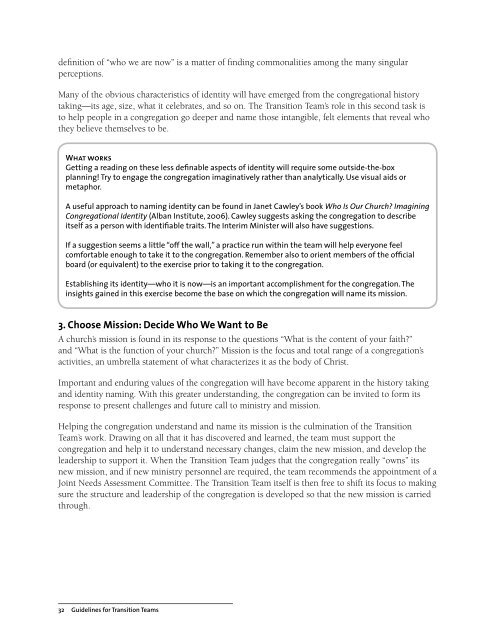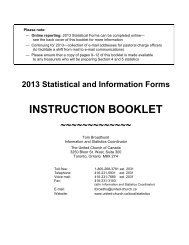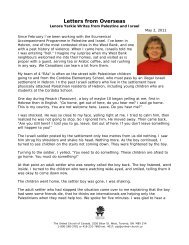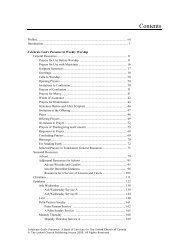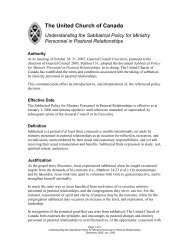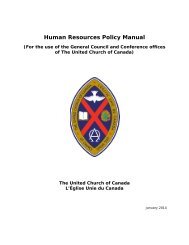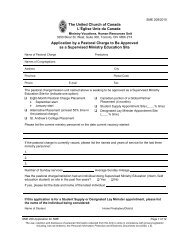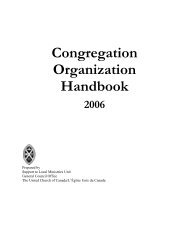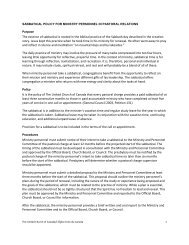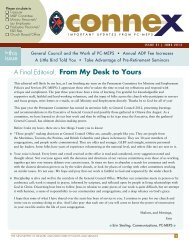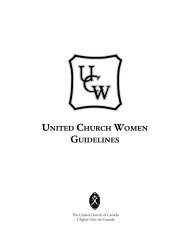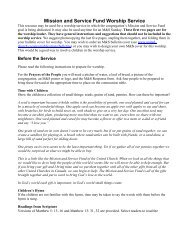Guidelines for Transition Teams - The United Church of Canada
Guidelines for Transition Teams - The United Church of Canada
Guidelines for Transition Teams - The United Church of Canada
You also want an ePaper? Increase the reach of your titles
YUMPU automatically turns print PDFs into web optimized ePapers that Google loves.
definition <strong>of</strong> “who we are now” is a matter <strong>of</strong> finding commonalities among the many singular<br />
perceptions.<br />
Many <strong>of</strong> the obvious characteristics <strong>of</strong> identity will have emerged from the congregational history<br />
taking—its age, size, what it celebrates, and so on. <strong>The</strong> <strong>Transition</strong> Team’s role in this second task is<br />
to help people in a congregation go deeper and name those intangible, felt elements that reveal who<br />
they believe themselves to be.<br />
What works<br />
Getting a reading on these less definable aspects <strong>of</strong> identity will require some outside-the-box<br />
planning! Try to engage the congregation imaginatively rather than analytically. Use visual aids or<br />
metaphor.<br />
A useful approach to naming identity can be found in Janet Cawley’s book Who Is Our <strong>Church</strong>? Imagining<br />
Congregational Identity (Alban Institute, 2006). Cawley suggests asking the congregation to describe<br />
itself as a person with identifiable traits. <strong>The</strong> Interim Minister will also have suggestions.<br />
If a suggestion seems a little “<strong>of</strong>f the wall,” a practice run within the team will help everyone feel<br />
com<strong>for</strong>table enough to take it to the congregation. Remember also to orient members <strong>of</strong> the <strong>of</strong>ficial<br />
board (or equivalent) to the exercise prior to taking it to the congregation.<br />
Establishing its identity—who it is now—is an important accomplishment <strong>for</strong> the congregation. <strong>The</strong><br />
insights gained in this exercise become the base on which the congregation will name its mission.<br />
3. Choose Mission: Decide Who We Want to Be<br />
A church’s mission is found in its response to the questions “What is the content <strong>of</strong> your faith?”<br />
and “What is the function <strong>of</strong> your church?” Mission is the focus and total range <strong>of</strong> a congregation’s<br />
activities, an umbrella statement <strong>of</strong> what characterizes it as the body <strong>of</strong> Christ.<br />
Important and enduring values <strong>of</strong> the congregation will have become apparent in the history taking<br />
and identity naming. With this greater understanding, the congregation can be invited to <strong>for</strong>m its<br />
response to present challenges and future call to ministry and mission.<br />
Helping the congregation understand and name its mission is the culmination <strong>of</strong> the <strong>Transition</strong><br />
Team’s work. Drawing on all that it has discovered and learned, the team must support the<br />
congregation and help it to understand necessary changes, claim the new mission, and develop the<br />
leadership to support it. When the <strong>Transition</strong> Team judges that the congregation really “owns” its<br />
new mission, and if new ministry personnel are required, the team recommends the appointment <strong>of</strong> a<br />
Joint Needs Assessment Committee. <strong>The</strong> <strong>Transition</strong> Team itself is then free to shift its focus to making<br />
sure the structure and leadership <strong>of</strong> the congregation is developed so that the new mission is carried<br />
through.<br />
32 <strong>Guidelines</strong> <strong>for</strong> <strong>Transition</strong> <strong>Teams</strong>


